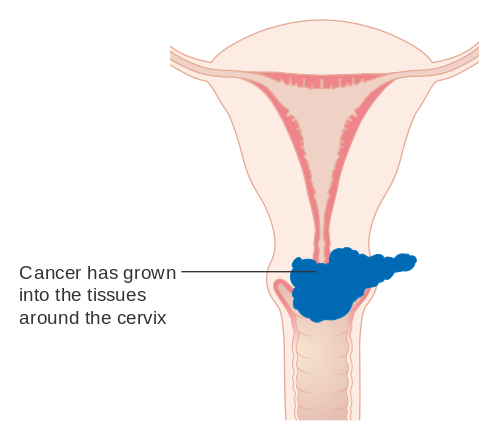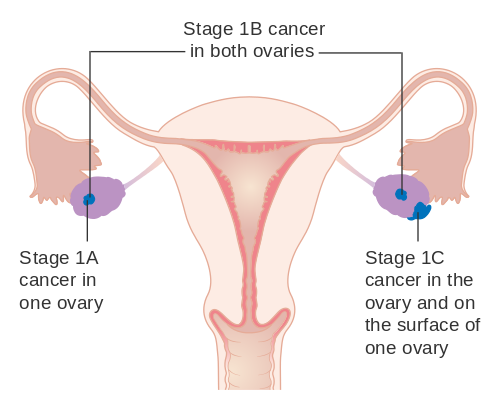Difference Between Cervical Cancer vs Ovarian Cancer
What is Cervical Cancer and Ovarian Cancer?
Both cervical cancer and ovarian cancer can result in pelvic pain and vaginal bleeding, but the rest of the symptoms differ.

What is Cervical Cancer?
Cervical cancer is found in the cervix and thus is the cancer arising from the cervix. The reason for this type of cancer is the abnormal growth of cells that have the tendency to spread or invade to other parts of the body. Initially, no symptoms are found. At an advanced stage, symptoms seen may include pelvic pain, abnormal vaginal bleeding, or pain during sexual intercourse.
The main categories of cervical cancers are adenocarcinoma and squamous cell carcinoma. Most (up to nine out of ten) cervical cancers are squamous cell carcinomas. Such cancers can be seen in exocervix cells and the cancer cells appear like squamous cells under the microscope.

What is Ovarian Cancer?
Ovarian cancer occurs when abnormal malignant cells in the ovary start to multiply uncontrollably and form a tumor. Such a condition is termed as metastatic ovarian cancer. The ovaries are 2 female reproductive glands that release eggs or ova. They reproductive glands also produce the female hormones progesterone and estrogen.
Ovarian cancer categories include:
- Epithelial tumors
– start in the thin tissue layers which cover the ovaries from outside. About ninety percent of cancers of ovaries are epithelial tumors.
- Stromal tumors
– start in the ovarian tissue which contains hormone-producing cells. Such tumors are diagnosed earlier than other ovarian tumors. Around seven percent of ovarian tumors are stromal
- Germ cell tumors
– start in the egg-releasing cells. These tumors tend to occur in younger women
Difference between Cervical Cancer and Ovarian Cancer
-
Definition
Cervical Cancer
It is a malignant tumour of the cervix that can be seen in the lowermost part of the uterus. Cervical cancer is a result of some strains of the human papillomavirus (HPV). HPV is a common virus which is passed on by sexual contact.
Ovarian Cancer
It is a malignant tumour that starts in the female organs that produce eggs (eggs from the ovaries). Ovarian cancer usually is not detected in early stages until it has spread to the stomach and pelvis. At the advanced stage, ovarian cancer is very difficult to treat and can be fatal.
-
Symptoms
Cervical Cancer
- Painful urination
- Discharge that is unusual in color, amount, smell or consistency
- Excessive tiredness
- Swollen or painful legs
Ovarian Cancer
- Abdominal bloating and swelling
- Alteration of bladder habits
- Pelvic pain
- Persistent indigestion, nausea or gas
- Loss of appetite
- Change in bowel habits (such as the symptoms of IBS)
- Feeling like you get full very quickly while eating
- Pain in your tummy
-
Causes
Cervical Cancer
- Virus called human papilloma virus (HPV). The HPV spreads through sexual contact
- Smoking
- Having many children
- Use of birth control pills
Ovarian Cancer
Inherited gene mutations. The genes that increase the risk of ovarian cancer are called breast cancer gene 1 (BRCA1) and breast cancer gene 2 (BRCA2).
-
Risk factors
Cervical Cancer
- Human papillomavirus (HPV) infection
- Smoking
- Weak Immune System
- Chlamydia infection
- A diet low in fruits and vegetables
- Being overweight (Women who are overweight are more likely to develop adenocarcinoma of the cervix)
- Long-term use of birth control pills (oral contraceptives)
- Intrauterine device (IUD) use
- Having multiple full-term pregnancies
- Being younger than 17 at your first full-term pregnancy
- Economic status (low-income women have no access to quality health care services, including Pap tests. And as a result, they may not get diagnosed or treated for cervical pre-cancers)
- Diethylstilbestrol (DES)
- Having a family history of cervical cancer
Ovarian Cancer
- Older age
- Inherited gene mutations
- Family history of ovarian cancer
- Estrogen hormone replacement therapy
- Age when menstruation started and ended
-
Survival rate
Cervical Cancer
Cervical cancer has been found to have a 72% survival rate.
Ovarian Cancer
Ovarian cancer has been found to report the lowest survival rate of any female’s cancer and only forty four percent of female’s diagnosed will live 5 years after being diagnosed.
-
Treatment
Cervical Cancer
- Chemotherapy
- Brachytherapy
- Cervical Conization
- Teletherapy
- Loop electrosurgical excision procedures
- Surgery (Hysterectomy, Cervicectomy, Cryosurgery, Lymph node dissection, Retroperitoneal lymph node dissection)
Ovarian Cancer
- Treatment of Invasive Epithelial Ovarian Cancers, by Stage
- Treatment for Germ Cell Tumors of the Ovary
- Radiation Therapy for Ovarian Cancer
- Treatment for Stromal Tumors of the Ovary, by Stage
- Treatment for Epithelial Tumors of Low Malignant Potential
- Surgery for Ovarian Cancer
Summary of Cervical Cancer vs. Ovarian Cancer
The points of difference between Cervical cancer and Ovarian cancer have been summarized below:

- Difference Between Global Warming and Greenhouse Effect - May 18, 2024
- Difference Between Vaccination and Immunization - March 3, 2024
- Difference Between Selective Mutism and Autism - February 25, 2024
Search DifferenceBetween.net :
Leave a Response
References :
[0]Image credit: https://upload.wikimedia.org/wikipedia/commons/thumb/f/f7/Diagram_showing_stage_2B_cervical_cancer_CRUK_216.svg/500px-Diagram_showing_stage_2B_cervical_cancer_CRUK_216.svg.png
[1]Image credit: https://upload.wikimedia.org/wikipedia/commons/thumb/5/56/Diagram_showing_stage_1_ovarian_cancer_CRUK_193.svg/500px-Diagram_showing_stage_1_ovarian_cancer_CRUK_193.svg.png
[2]Balkwill, F., Bast Jr, R. C., Berek, J., Chenevix-Trench, G., Gore, M., Hamilton, T., ... & Ursulic, S. (2003). Current research and treatment for epithelial ovarian cancer A Position Paper from the Helene Harris Memorial Trust. European journal of cancer, 39(13), 1818-1827.
[3]Finocchario-Kessler, S., Wexler, C., Maloba, M., Mabachi, N., Ndikum-Moffor, F., & Bukusi, E. (2016). Cervical cancer prevention and treatment research in Africa: a systematic review from a public health perspective. BMC women's health, 16(1), 29.
[4]Modugno, F., & Edwards, R. P. (2012). Ovarian Cancer: Prevention, Detection and Treatment of the Disease and Its Recurrence. Molecular Mechanisms and Personalized Medicine Meeting Report. International journal of gynecological cancer: official journal of the International Gynecological Cancer Society, 22(8), S45.
[5]Nour, N. M. (2009). Cervical cancer: a preventable death. Reviews in Obstetrics and Gynecology, 2(4), 240.
